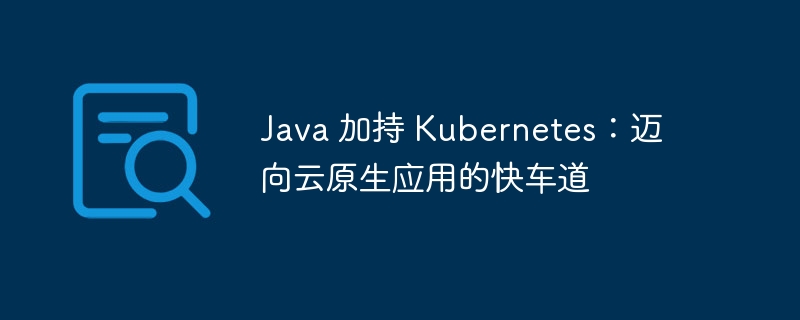Home >Java >javaTutorial >Java supports Kubernetes: the fast lane towards cloud-native applications
Java supports Kubernetes: the fast lane towards cloud-native applications
- WBOYWBOYWBOYWBOYWBOYWBOYWBOYWBOYWBOYWBOYWBOYWBOYWBforward
- 2024-02-29 19:16:061080browse

Java supports Kubernetes: the fast lane towards cloud-native applications. This article is a wonderful exploration brought to you by php editor Xinyi. With the development of cloud native technology, Java, as a commonly used programming language, has shown strong application potential on the Kubernetes platform. This article will explain in detail the application scenarios, advantages and challenges of Java in Kubernetes, helping developers make better use of this fast lane and create efficient and stable cloud-native applications.
Why use Java for Kubernetes?
- Widespread Adoption: Java is a programming language widely adopted by enterprises, with a large and skilled developer community.
- Mature Ecosystem: Java has a rich ecosystem of libraries, frameworks, and tools that simplify the development of cloud-native applications.
- High Performance: Java Virtual Machine (JVM) provides excellent performance and scalability, making it ideal for handling high-load applications choose.
Benefits of Kubernetes for Java Applications
Kubernetes provides many advantages for Java applications, including:
- Automated Deployment: Kubernetes Automates the application deployment process, simplifying the conversion of code from development to production.
- Container isolation: Kubernetes packages applications into independent containers, providing isolation and portability.
- Automatic scaling: Kubernetes automatically scales applications based on demand, ensuring high availability and performance.
- Security Enhancements: Kubernetes provides powerful security measures for networking, storage, and access control.
Deploying Java Applications on Kubernetes
Deploying a Java application on Kubernetes involves the following steps:
- Writing a Dockerfile: Create a Dockerfile that contains the dependencies and code required by your Java application.
- Build the image: Use the Docker command to build a Docker image that contains the application and necessary dependencies.
- Create a deployment: Create a deployment object in the Kubernetes cluster and define the containerized version, number of replicas, and port of the application.
- Service exposure: Create a service object to expose the application in an externally accessible way.
Demo code:
The following demo code shows how to deploy a simple Java Spring Boot application using Kubernetes:
apiVersion: v1 kind: Deployment metadata: name: my-java-app spec: replicas: 2 selector: matchLabels: app: my-java-app template: metadata: labels: app: my-java-app spec: containers: - name: my-java-app image: my-java-app:latest ports: - containerPort: 8080 --- apiVersion: v1 kind: Service metadata: name: my-java-app-service spec: selector: app: my-java-app ports: - port: 80 targetPort: 8080
in conclusion
Combining Java with Kubernetes provides enterprises with a powerful platform for developing and deploying cloud-native applications. By leveraging Kubernetes' automation, containerization, and security capabilities, Java developers can accelerate application development, increase scalability, and reliability while taking full advantage of cloud computing.
The above is the detailed content of Java supports Kubernetes: the fast lane towards cloud-native applications. For more information, please follow other related articles on the PHP Chinese website!

